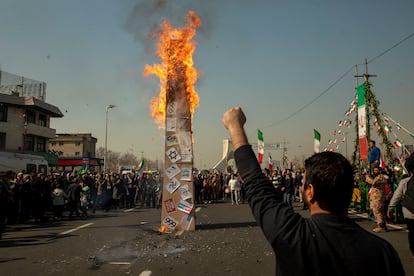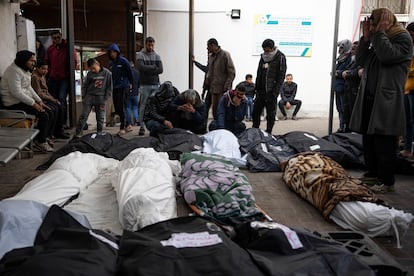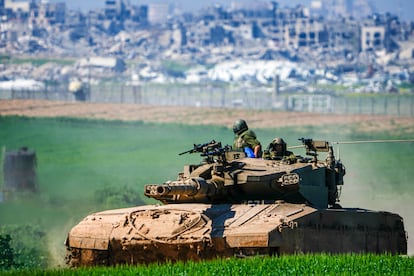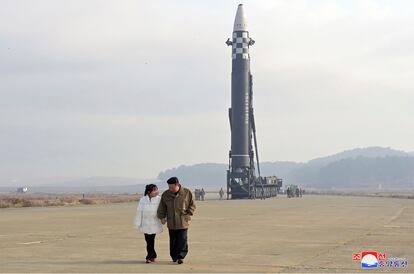The world is facing the worst war scenario in half a century
The strategic significance of the conflicts in Ukraine and the Middle East, the friction between the U.S. and China and the possible return of Trump make for a high-risk horizon

The world is simultaneously facing two wars — in Ukraine and the Middle East — with enormous geopolitical significance. Meanwhile in the Korean peninsula, there is growing concern about the alarming turn in North Korea’s rhetoric. Taiwan also remains a hotspot after a party China opposes won the presidential elections for a third time in row. While the world has always seen terrible conflicts, such as the civil conflict now ravaging Sudan, the current scenario is characterized by conflict between large and medium powers, the likes of which have not been seen in decades.
For the first time since 1945, Europe is witnessing a major war, in which a great power has invaded another country not only to subjugate it but also to annex territory. Around 30 Western countries are providing aid to Ukraine to help its efforts to repel Russia, which in turn is assisted militarily by Iran, North Korea, and Belarus. But U.S. support for Kyiv is wavering, and this is strengthening Moscow’s position. The situation is so dire that several European political and military leaders have stressed that there is a real risk that the conflict will reach Western Europe. The possibility that Donald Trump — who opposes America’s involvement in NATO — may return to the White House has further heightened tensions.
“We have to take into account that Vladimir Putin might even attack a NATO country one day. It is unlikely to happen now, but our experts expect a period of five to eight years in which this could be possible,” German Defense Minister Boris Pistorius, a Social Democrat, said in a recent interview. Danish Defense Minister Troels Lund Poulsen, a liberal, reduced that time window to between three and five years. “There could be war in Sweden,” Carl-Oskar Bohlin, the Swedish minister for civil defense and a moderate, said in January.
The Middle East, for its part, is experiencing the most dangerous situation “since at least 1973, and arguably even before that,” according to U.S. Secretary of State Antony Blinken. As feared, the conflict between Hamas and Israel has escalated and a dozen countries are already directly involved in wide-spreading hostilities. In retaliation, the U.S. has bombed targets in Yemen, Iraq and Syria. The U.S. strikes against groups affiliated with Iran’s Revolutionary Guard has put Washington and Tehran in a dangerous direct line of fire. Both sides have signalled that they want to avoid an escalation. But in the region there are actors beyond their control who, more or less intentionally, are fueling the fire.
Meanwhile, in East Asia, North Korea has taken an abrupt turn by removing from its Constitution the commitment to seek “peaceful reunification,” while developing new weapons and strengthening ties with Putin’s Russia. Further south, the Taiwan question continues to pose a threat amid the non-violent but heated competition between the two superpowers, the United States and China. This is happening against the backdrop of the changing balance of power, as Graham Allison, former U.S. Deputy Secretary of Defense, recently recalled at the Davos Forum.
While in recent decades there have been other wars with terrible human consequences and significant geostrategic repercussions, such as the conflicts in Afghanistan, Iraq, the Balkans, the Democratic Republic of Congo, and Syria, the current scenario holds a level of geopolitical risk that has not been seen since the Cold War.
The number of victims is also striking. According to a study by the Oslo Peace Research Institute (PRIO), 2022 saw the highest number of deaths from state wars — in which at least one actor is a state — since the early 1970s with the exception of 1984. Over 200,000 people died in state wars, largely due to the conflicts in Ukraine and Ethiopia (1994 would have a high death toll if the conflict in Rwanda was also included, but the PRIO lists it in another category). It is reasonable to think that 2023 — when the crisis in Ethiopia eased, but the conflict in Gaza erupted — will also be a bad year in the yet-to-be-published death toll. Israeli Prime Minister Benjamin Netanyahu’s mission to push further into the south of Gaza is likely to increase the number even more. More than 100 million people worldwide are refugees or displaced, the highest figure on record.
But the danger lies above all in the geopolitical situation. “We have entered a period with greater interstate conflict. We are in an era of direct competition between major countries”, says Meia Nouwens, an expert at the International Institute for Strategic Studies. “This is concerning. And so is the level of cooperation that we see, for example, between China, Russia, Iran, and North Korea, which is new to a degree. As for context, there is a disturbing collapse of communication, of trust, the mechanisms that would have ensured stability in the past”. Old arms control treaties between the U.S. and Russia are collapsing, and there is no prospect of new ones being signed with China.
Sergey Radchenko, a historian specialized in the Cold War and professor at the School of Advanced International Studies at Johns Hopkins University, also highlights the conflict between the world’s great powers. “The current period has differences with the Cold War. There is no ideological confrontation like then. There are democracies on the one hand and regimes on the other, but it is not the same. And there is an interdependence that didn’t exist then,” he comments. “But there are things that are similar: one is the power struggle between powers. Another similiarity is how the nuclear specter is conditioning that fight.”
The future is not set in stone, and the situation may not worsen. There are encouraging signs, such as Washington and Beijing’s efforts to restore relations, the clear signals issued by the United States and Iran that they do not want an escalation, and the movements underway to seek a negotiated solution to the Gaza conflict.
But it is evident that there are actors determined to seek destabilization. The possibility of other actors becoming involved, or of unintentional escalations, cannot be ruled out either. Here is an analysis of the three main sources of geopolitical tension, based on opinions from experts interviewed by telephone last Thursday.

Ukraine
Ukrainian President Volodymyr Zelenskiy said in his speech at a plenary session of the World Economic Forum in Davos: “If anyone thinks this is only about us, this is only about Ukraine, they are fundamentally mistaken. Possible directions and even timelines of new Russian aggression beyond Ukraine become more and more obvious.”
Zelenskiy did not mention specific timelines or directions, but in a later meeting with an international group of journalists, when asked about the prospect of Trump returning to the White House, his sigh was telling. There are clear signs that a Trump victory would put an end to U.S. aid to Ukraine and raise questions about Washington’s commitment to mutually defend its allies. In the timeline discussed by Zelenskiy, the date of the U.S. presidential elections is clearly marked.
Putin often says that he has no intention of attacking other countries, a point he reaffirmed in his interview with Tucker Carlson. But he also publicly denied any plans to attack Ukraine. It is interesting to remember what he said at the last Valdai forum: “This is not a territorial conflict and not an attempt to establish regional geopolitical balance. The issue is much broader and more fundamental and is about the principles underlying the new international order.” In other words, if this is not just about Ukraine and the region, but rather about supposed principles, there is nothing stopping him from defending those principles in other countries.
In the West, this prospect is taken increasingly seriously. “The alarmist statements by European political and military officials are an attempt to prevent that from happening,” says Radchenko, whose new book, To Run the World: The Kremlin’s Cold War Bid for Global Power, will be published in May. “The conflict can be avoided if Europe is prepared for it. Russia today is a country that, under Putin, is seeking to take advantage of weakness. Weakness invites aggression, strength deters it. That’s why warnings seek to raise awareness, to create an understanding that helps countries prepare, which is the best way to avoid a war,” says the historian.
The Russian invasion of Ukraine is a huge undertaking: 35% of all Russian public spending goes to war. China has helped Russia circumvent the restrictions on accessing Western technologies, and bilateral trade has grown a lot, reaching over $200 billion in 2023. But Beijing is also pressuring Moscow, for example, by slowing down the launch of a new Russian-Chinese gas pipeline in a bid to push the Kremlin to give in and agree to more favorable conditions. Despite this, it is evident that Putin has stabilized the situation and is turning Russia into a war economy.
Radchenko argues that Putin’s strategic objective is to “recover Russia’s place as a great power” and use this mission “to legitimize his position.” Putin wants to be seen as the indispensable leader returning Russia to greatness and fighting against all who allegedly want to undermine the country — far from a reassuring position.
And if the United States does not guarantee its support, Europe is far from having a credible deterrent because it is not a united front. Its armed forces are fragmented, have interoperability problems, and are not used to fighting. But, above all, there is no political unity. “If the Americans give up their leadership, which may well happen if Trump wins, can we really expect the Europeans to push forward as a united force? We can’t,” says Radchenko.
As a result, the war in Ukraine is at a complicated phase, with Kyiv suffering from a shortage of supplies. But the outlook is potentially much more problematic. It is a key strategic challenge for the world and an existential threat for Europe.

Middle East
While there is the war in Ukraine in Europe, the Middle East is going through its most turbulent period in decades. There are two different sides to the tension, which feed into one another. The first is the conflict between Hamas and Israel. The second is the confrontation of forces in the region, with Iran and its partners on the one hand, and the United States and Israel, on the other.
At the forefront is Israel’s brutal response to the Hamas attack, which is causing devastating human suffering in Gaza. Diplomatic efforts are underway to end the hostilities, with the United States, Qatar, Saudi Arabia, and Egypt playing key roles.
“This mediation effort is coming up against serious problems, especially because Netanyahu has a vested interest in continuing the fighting. There is a widespread feeling in Israel that as soon as hostilities end, so will Netanyahu’s mandate,” says Hugh Lovatt, a Middle East expert at the European Council on Foreign Relations. Even before the current crisis, Netanyahu was a divisive leader who was facing criticism for alleged corruption cases and for promoting measures that many Israelis believed were harmful to democracy. Netanyahu’s total failure to foresee and contain the Hamas attack has damaged his reputation, perhaps permanently.

“And the resulting problem is that the conflict in Gaza is leading to regional escalation. While the problems in the region have their own causes and dynamics, the Gaza crisis is aggravating them,” Lovatt continues. “Neither Israel, nor Iran, nor Hezbollah want a regional war, and they have measured their actions to avoid it. But if the crisis in Gaza continues, the risks increase for several reasons. Iran and its partners may feel pressure to appear to be doing something. Tehran does not have absolute control over its partners and some may act out of self-interest. And finally, there is an increased risk of unintentional escalation. It is likely that the attack on the Jordanian base that killed American soldiers was not intended to have that result,” says Lovatt.
The United States, which also does not want the conflict to escalate, has responded in a calculated way to prevent this from happening — giving Iran time to relocate its forces and striking surgically a week later. But when you are playing with fire, a fire is likely.
“In my opinion, we are already in a regional war, but it is a largely contained and low-intensity war, with measured attacks. But as long as the war in Gaza continues, the risk of full and uncontrolled escalation will grow even if few have a stake in it,” Lovatt argues.
The latest news is alarming. Netanyahu has ordered the Israeli Armed Forces to prepare an offensive against Rafah, in southern Gaza, where a large part of the Gazans displaced by Israel’s brutal military operation in the Strip are living in overcrowded conditions. This stage in the war could cause terrible harm to civilians and further destablize the geopolitical situation. Meanwhile, America’s enemies are watching with delight as Washington is forced to deal with other fronts.
East Asia

The tension in East Asia is the last element of the global big picture. North Korea’s leader, Kim Jong-un, made an abrupt political turn, renouncing the traditional goal of peaceful reunification with the South, while continuing to develop his arsenals, including nuclear weapons. Reputable analysts fear that this is an attempt to lay the ideological foundations for warlike actions. Veteran U.S. diplomat Robert Carlin and nuclear scientist Siegfried Hecker argue that the situation is the most dangerous it has been since the 1950s.
Some experts fear that the perception that the United States is in decline — weighed down by dysfunctional policy, having made a sudden withdrawal in Afghanistan and now caught up in Ukraine and the Middle East, and facing a possible complicated transition of power — may motivate some to make a move. Meanwhile, North Korea has been strengthening ties with Russia, providing it with a huge amount of ammunition for the war in Ukraine.
“I find Kim Jong-un’s statements particularly alarming. We are witnessing the resurgence of the awareness that the North Korean leader might want to at some point be adventurous in his decision making,” says Meia Nouwens, from the IISS, who specializes in China and East Asia. “I think this year he will develop new defense capabilities. Is this preparation for a military attack? Or a strategic positioning to have more leverage ahead of 2025 and a possible return of Trump? I think the latter is more likely,” says the expert.
The other potential hotspot is Taiwan. The third straight victory of the Taiwan Democratic Progressive Party (DPP) in the presidential elections is not good news for Beijing. However, Nouwens notes, the fact that the party did not win a parliamentary majority means that the worst scenario from the point of view of the Communist Party of China (CPC) has been averted. “What this means, I think, in military terms, is that there will be no huge change in the next four years. We will continue to see Beijing’s focus on the gray zone, maritime and air raids, and disinformation,” says the expert.
In this region, a lot depends on relations between China and the United States. The two superpowers have shown signs of wanting to thaw the frosty relationship. “Since [the meeting between U.S. President Joe Biden and Chinese President Xi Jinping in] San Francisco, we have been seeing positive developments, in the sense that the two countries are trying to dialogue, establish channels, even between the armed forces. But, it is a very narrow approach. There is grave mistrust between the two countries. Both recognize that they have no interest in a conflict. But it is a very fragile stability that unexpected events could derail,” says Nouwens.
China is in the midst of an economic slowdown. This can cause internal discontent. There are those who fear that, to divert attention from the waning economy, the regime could hit the nationalist button harder. “I’m not convinced by this argument. I think Xi has been clear to the people that in the period ahead it has to prepare itself for struggle. I don’t think they’ll use conflict as an instrument for distraction. Beijing has not acted like this in the past and I would also say that, right now, China’s military is not in a very stable state, at least in terms of the corruption allegations within the missile force and the subsequent changes in the top command and the disappearance of leaders, such as the former defense minister,” says Nouwens.
This is the picture. The big unknown is how a Trump victory may impact it. Meanwhile, the brutal violence continues.
Sign up for our weekly newsletter to get more English-language news coverage from EL PAÍS USA Edition
Tu suscripción se está usando en otro dispositivo
¿Quieres añadir otro usuario a tu suscripción?
Si continúas leyendo en este dispositivo, no se podrá leer en el otro.
FlechaTu suscripción se está usando en otro dispositivo y solo puedes acceder a EL PAÍS desde un dispositivo a la vez.
Si quieres compartir tu cuenta, cambia tu suscripción a la modalidad Premium, así podrás añadir otro usuario. Cada uno accederá con su propia cuenta de email, lo que os permitirá personalizar vuestra experiencia en EL PAÍS.
¿Tienes una suscripción de empresa? Accede aquí para contratar más cuentas.
En el caso de no saber quién está usando tu cuenta, te recomendamos cambiar tu contraseña aquí.
Si decides continuar compartiendo tu cuenta, este mensaje se mostrará en tu dispositivo y en el de la otra persona que está usando tu cuenta de forma indefinida, afectando a tu experiencia de lectura. Puedes consultar aquí los términos y condiciones de la suscripción digital.
More information
Archived In
Últimas noticias
Maduro pleads not guilty before the federal court in New York: ‘I am still the president of Venezuela’
A new test can detect Alzheimer’s from a finger prick
UN team enters Sudanese city of El Fasher after paramilitary massacre: ‘It’s like a ghost town’
A recipe for resistance: Indigenous peoples politicize their struggles from the kitchen
Most viewed
- Gilles Lipovetsky: ‘If you want to live better and fall in love, take Prozac, don’t look to philosophy’
- Alain Aspect, Nobel laureate in physics: ‘Einstein was so smart that he would have had to recognize quantum entanglement’
- Alvin Hellerstein, a 92-year-old judge appointed by Bill Clinton, to preside over Maduro’s trial in New York
- Maduro’s downfall puts China’s relationship with Venezuela to the test
- Why oil has been at the center of Venezuela-US conflicts for decades










































